
The role of packaging has dramatically evolved over the years. While the fundamental principle behind packaging remains, in that it needs to be functional and practical, a container that enables people to transport their product from one place to another, packaging itself is becoming as complex as the technology used in the production process.
Today, not only does packaging still have to preserve the product, especially within the food industry, it also helps to drive changes, meet new environmental standards, and be both eye-catching and lighter in weight.
With manufacturers needing to continually re-invent themselves and their products to remain fresh in the eye of the consumer and meet current trends, navigating through the myriad of packaging options available to them just adds another layer of complexity to the process of getting their product to the consumer.
Selecting the right packaging option which ticks every box is a complicated process, and one which often demands a full department of specialists for well established brands. However, this is not often the option for smaller manufacturers, and deciding upon the best packaging solution for their brand and product, can be very complicated as there are so many elements to take into consideration.
While the role of the packaging supplier is getting even more complicated once new emerging materials, and different board types are factored in, it is their responsibility to educate the manufacturer to ensure they are equipped with all of the relevant information, giving them full control to make the right decision for their product, and their brand.
Creating a sustainable solution…..
Increased environmental awareness has grown significantly in the last three decades. Today, the standards are high, and there is a growing band of eco-friendly packaging materials on the market. The choices are endless; from biodegradable, recycled, to fully compostable paperboard. To ensure they make the right decision, a manufacturer should take full control of selecting a packaging supplier who meets their sustainable goals. From how they source and dispose of their material, to their transparency over partnerships with accreditations like the FSC and PEFC as well as the EN 13432.
While there is a lack of recycling infrastructure in the UK, this shouldn’t stop or limit the packaging supplier from suggesting only one type of material as a solution. The supplier simply needs to inform the manufacturer effectively to ensure that they clearly document the disposal route of the packaging. Sometimes, the best solution may involve materials which can not, currently, be effectively recycled within the existing infrastructure, but they may save money in terms of food waste, keep the product safe and cut down on carbon footprint by being easy to transport, or produced locally.
Choose the right material…….
For some time, retailers have been squeezing food manufacturers to lower their costs, while pushing them to move away from plastic packaging. Consequently, manufacturers need to be fully aware of the role of alternatives while seeking the best solution for their product. They also need to be educated on the benefits of using a combination of packaging, for instance suggesting just a compostable paperboard may not answer or simplify the process, ideally, it’s a blend of several materials, plus listening to a packaging suppliers expertise, which will give the best solution. Also, there is still a place for plastic. For instance, excellent visibility, particularly for fresh food, is a crucial element of the decision making process for customers. In this case a paperboard base and clear window, offers a good solution and what many manufacturers do not realise is that these windows can be created from recyclable and compostable acetate, a film produced from wood pulp. On top of this, there is the construction element which needs to be factored in, the right packaging solution should add efficiency and speed to the entire production process.
Brand perception…..
Packaging is a huge element of making products seem more attractive, and the semiotics of the on pack messaging can definitely help brands create greater shelf appeal. This means that the packaging a manufacturer chooses will require attention to both the materials themselves, and the messaging, as the visual appeal is vital in grasping consumer attention, conveying the product, and gaining repeat business. They need to think of the packaging much earlier than the end of the process and look at it as an investment, rather than an additional cost.
Manufacturers also need to ask themselves whether the seasons could affect their product and potential sales. For instance, adapting the packaging and on pack messaging around Christmas could attract a wider audience. If this is factored in, then a packaging supplier will be able to inform them whether shorter print runs are possible.
Be prepared…….
Ultimately, manufacturers need to be committed to working with the right packaging supplier and materials. Many suppliers will offer a facility to trial and test its packaging solutions, which may provide reassurance that they have selected the right option, or it may flag weaknesses and offer scope for improvements. This may require further trials on the different options, but a manufacturer must be prepared to choose alternative solutions, which may not be far off their original idea, but won’t compromise on the final result.



